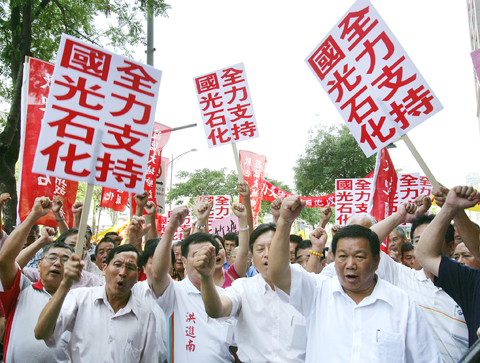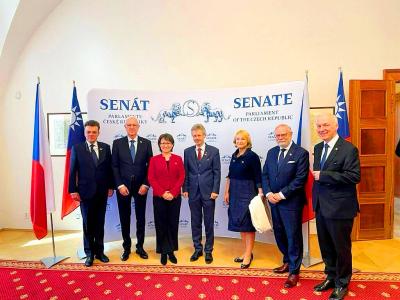An Environmental Protection Administration (EPA) committee decided yesterday that Kuokuang Petrochemical Technology Co’s plan to build an industrial park on reclaimed land in Changhua County needs to undergo a more thorough environmental impact assessment (EIA).
Second-stage EIAs, which are more detailed and have tighter requirements, are usually only required for developments deemed to pose “serious implications for the environment.”
“The proposal will seriously impact on the local environment, its nearby fish farms, ecosystem, flood regulatory system, underground water and soil and air quality. Kuokuang should also communicate with local residents more clearly regarding health risks,” the EIA case committee chairperson said after the committee voted overwhelmingly to send the proposal to a second-stage EIA.

PHOTO: CNA
The decision could mean delays for Kuokuang’s NT$800 billion development along the northern bank of the Chuoshui River (濁水溪).
Kuokuang chairman Chen Pao-lang (陳寶郎) said the company “gladly accepts the ruling” and will work hard to get a green light.
An environmentalist who wished to remain anonymous said the ruling might appear to be a “setback” for the company but was simply “a show staged to get environmental groups to relax their guard.”
“Kuokuang intentionally presented a very poor EIA proposal today so that it would have to enter the second stage. However, the company already has a plan in hand to pass the second EIA. It has completed all the data and studies necessary for a second stage,” the environmentalist said.
Supporters and opponents spoke before the EIA case committee during the four-hour meeting.
Taiwan Environmental Protection Union (TEPU) Changhua Chapter chairman Tsai Chia-yang (蔡嘉陽) said that the reclaimed land — a project ordered by former Changhua County commissioner Wong Chin-chu (翁金珠) — had been undertaken to alleviate severe subsidence problems in the area.
“More land will need to be reclaimed to build the industrial park and seaport, but that will worsen the subsidence instead of alleviating it,” he said.
TEPU Changhua Chapter director Shih Yueh-ying (施月英) said a consensus had been reached during the National Energy Conference in April to make the nation’s petrochemical industry meet Taiwan’s energy needs without producing products for export.
“I would be okay with the idea of reclaiming land for survival, but reclaiming land for a sunset industry like petrochemicals is unacceptable,” she said.
Former EIA panelist Lee Ken-cheng (李根政) turned to the health risks the project poses to area residents, saying that while local residents had high hopes the development would bring economic prosperity, they could be disappointed.
“The factory will only bring economic prosperity to a handful of local government officials and Kuokuang’s management. The number of jobs may not be as high as local residents think. CPC Corp, Taiwan’s Kaohsiung plant only has 1,700 employees,” Lee said.
“The proposed plant could even hire foreign labor for up to 50 percent of its work force, which means local residents would not really benefit,” he said.
Residents had not considered the health risks and environmental costs, he said.
“Near the Sixth Naphtha Cracker plant in Yunlin County, the cancer rate for females is 15 times the national average,” Lee said.
“In 1987, former Ilan County commissioner Chen Ding-nan (陳定南) rejected Formosa Plastic Group’s proposal to build the Sixth Naphtha Cracker in his county, and now Ilan has become a tourism hotspot. In contrast, Yunlin County is the poorest county in the country and it has the nation’s highest cancer rate,” he said.
Local officials disagreed.
“We care about the environment, too. The subsidence problems can be resolved by the plant’s construction,” Changhua County Councilor Hung Ho-lu said.
“I urge EIA panelists not to say no to someone who is willing to invest in our land,” he said.
Tien-tou Village (田頭) chief Tsai Chi-rui (蔡啟瑞) said that 98 percent of local residents want the industrial park.
“Young people in our village leave because they cannot find jobs,” Tsai said. “You say that Ilan doesn’t have cancer, but didn’t Chen Ding-nan die of cancer?”

The Mainland Affairs Council (MAC) today condemned the Chinese Communist Party (CCP) after the Czech officials confirmed that Chinese agents had surveilled Vice President Hsiao Bi-khim (蕭美琴) during her visit to Prague in March last year. Czech Military Intelligence director Petr Bartovsky yesterday said that Chinese operatives had attempted to create the conditions to carry out a demonstrative incident involving Hsiao, going as far as to plan a collision with her car. Hsiao was vice president-elect at the time. The MAC said that it has requested an explanation and demanded a public apology from Beijing. The CCP has repeatedly ignored the desires

Many Chinese spouses required to submit proof of having renounced their Chinese household registration have either completed the process or provided affidavits ahead of the June 30 deadline, the Mainland Affairs Council (MAC) said on Thursday. Of the 12,146 people required to submit the proof, 5,534 had done so as of Wednesday, MAC deputy head and spokesperson Liang Wen-chieh (梁文傑) said. Another 2,572 people who met conditions for exemption or deferral from submitting proof of deregistration — such as those with serious illnesses or injuries — have submitted affidavits instead, he said. “As long as individuals are willing to cooperate with the legal

The Ma-anshan Nuclear Power Plant’s license has expired and it cannot simply be restarted, the Executive Yuan said today, ahead of national debates on the nuclear power referendum. The No. 2 reactor at the Ma-anshan Nuclear Power Plant in Pingtung County was disconnected from the nation’s power grid and completely shut down on May 17, the day its license expired. The government would prioritize people’s safety and conduct necessary evaluations and checks if there is a need to extend the service life of the reactor, Executive Yuan spokeswoman Michelle Lee (李慧芝) told a news conference. Lee said that the referendum would read: “Do

Taiwan's Vice President Hsiao Bi-khim (蕭美琴) said Saturday that she would not be intimidated by the Chinese Communist Party (CCP), following reports that Chinese agents planned to ram her car during a visit to the Czech Republic last year. "I had a great visit to Prague & thank the Czech authorities for their hospitality & ensuring my safety," Hsiao said on social media platform X. "The CCP's unlawful activities will NOT intimidate me from voicing Taiwan's interests in the international community," she wrote. Hsiao visited the Czech Republic on March 18 last year as vice president-elect and met with Czech Senate leadership, including